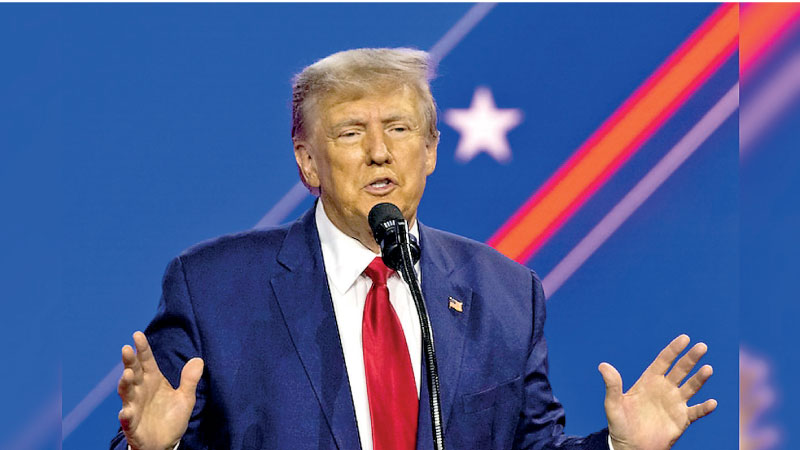Wednesday Feb 05, 2025
Wednesday Feb 05, 2025
Thursday, 28 November 2024 00:17 - - {{hitsCtrl.values.hits}}

US President Donald Trump
|
 In 2019, Syrian President Bashar al-Assad quipped that Donald Trump was the best US President, “not because his policies are good, but because he’s the most transparent president.” In some ways, it is better to have a foe who dispenses with the pretences of human rights and democracy, and says outright: “We want the oil”, “America first”.
In 2019, Syrian President Bashar al-Assad quipped that Donald Trump was the best US President, “not because his policies are good, but because he’s the most transparent president.” In some ways, it is better to have a foe who dispenses with the pretences of human rights and democracy, and says outright: “We want the oil”, “America first”.
Enough has been written about Trump’s politics since 2016, from his appeal in the deindustrialised US heartland, to his reigniting the old US political traditions of protectionism and isolationism. Rather than retread these themes, let us examine the likely policies of a second Trump administration, and the dangers and opportunities they hold for countries in the Global South.
Trumponomics
On trade policy, Trump has asked Robert Lighthizer to retake his position as US trade representative. Lighthizer is an enigmatic figure and an old school protectionist. His book No Free Trade recounts the history of US trade policy, and should be compulsory reading for any Global South policymakers who harbour illusions about free trade.
Lighthizer served as a trade negotiator under Ronald Reagan, back when the chief threat to US monopolies was not Chinese but Japanese industry. Neoliberalism is often associated with austerity, trade liberalisation, and deregulation, with Ronald Reagan being one of its global faces. Yet Regan, with the help of people like Lighthizer, conducted one of the most vicious mercantilist campaigns in modern history, mobilising the full power of the state to subordinate Japanese industrialism.
Neoliberalism, then, is better understood as the counterinsurgency of imperialism, rather than any specific economic policy. Imperialism is nothing but the efforts of international monopoly capital to control overseas markets and prevent the rise of competitors. Trump is transparent about it.
On fiscal policy, Trump is set to continue the trend of expanding budget deficits. A report by the Committee for a Responsible Federal Budget has projected that Trump’s campaign proposals would increase the national debt by $ 7.7 trillion (nearly double the projection of Kamala Harris’ $ 3.96 trillion). US Treasury yields jumped on election day, likely due to speculation over the Federal Reserve’s ability to accommodate Trump’s fiscal plans.
On monetary policy, Trump is on record stating that as President, he should, “have the right to put in comments as to whether or not the interest rate should go up and down”. During his last term as President, Trump slammed his own nominee for Federal Reserve Governor Jay Powell for not lowering interest rates fast enough. Trump’s running mate J.D. Vance has said that he has “come around to the Ron Paul argument” to abolish the Federal Reserve entirely.
So, here we are. A Trump presidency will likely see rising protectionism, widening budget deficits, and an erosion of Central Bank independence. The economics textbooks at Mar-a-Lago must have been put through the shredder, incinerated, and their ashes scattered across Silicon Valley.
Industrial policy for me, free trade for thee
One should not have any illusions that the Democrats would have been much different. What we are witnessing is a long-term trend. From the perspective of the Global South, the difference between the Democrats and the Republicans amounts mainly to a difference in the tempo and sequence of change.
It is a rather obscene irony that Argentina’s President Javier Milei is big fan of Trump. In Argentina, Milei enforces a merciless campaign of balanced budgets and trade liberalisation. In the US, Donald Trump does the opposite. But despite these differences in domestic policies, both are united in so far as they serve imperialism; Trump in the home market, and Milei in the foreign market.
The imperialist creed is, “industrial policy for me, free trade for thee”. Many in Sri Lanka, who are caught up in the hype, do not seem to realise that the theories and policies propounded by neoliberal think tanks like the Atlas Foundation-affiliated Advocata Institute and the Friedrich Naumann Foundation, have little to no influence in their own countries of origin. This particular brand of extreme economic libertarianism is exclusively an export product. When it comes to trade and industrial policy, there is more continuity than rupture between Democrats and Republicans.
For an underdeveloped country like Sri Lanka, no industrial policy tool should be off the table. Yet what the ongoing IMF program has done is flip the table entirely. The debt crisis is only postponed, with the underlying problem left unsolved: a lack of industrial development, and consequently a widening trade deficit. Sri Lanka is now saddled with an independent Central Bank, an institutional feature that is conspicuously absent in all stories of late industrialisation (China’s Central Bank is still not ‘independent’). Meanwhile, the IMF expects us to open up imports by next year.
Window of opportunity
Trump’s transparency opens up opportunities for industrial policy in two ways. First, Trump’s first administration threw the World Trade Organization (WTO) into disarray, and a second term will likely intensify this. There is now no need for countries like Sri Lanka to hold religiously to the WTO’s guidelines. We have a window of opportunity to experiment with trade policy in order to reduce the trade deficit and build up domestic production capacity in critical sectors like food. This will help shield against external shocks and encourage learning by doing.
Second, Trump’s tariffs against China may intensify the trend of an outflow of Chinese export-oriented manufacturing investment into South East Asia, Latin America, and parts of Eastern Europe. Sri Lankan policy makers need to be actively courting value-added manufacturing investment from China, leveraging our educated workforce and the strategically located Hambantota Port which can only succeed if it produces its own traffic through manufactured exports. This will help in the acquisition of new technology, diversifying the industrial structure, and generating export revenue.
One of the main challenges of a Trump presidency is the prospect of a strong and sustained rally for the US dollar. This would naturally place inflationary pressures on import-dependant countries like Sri Lanka, while driving interest rates up due to the institutionalisation of an inflation-targeting Central Bank. Most worrying is that a stronger dollar will impact Sri Lanka’s foreign debt burden, making raising revenue to repay debts much more challenging. Rising protectionism in the US, combined with China’s growing openness to the Global South, provide a window of opportunity for countries like Sri Lanka. Nothing more, nothing less. As with all opportunities, it is for us to lose. Will our leaders finally put Sri Lanka and Sri Lankans first?
(The writer is a researcher at Tricontinental: Institute for Social Research. He holds an MSc in Economic Policy from SOAS University of London. He can be reached at [email protected].)